View in other NatureServe Network Field Guides
NatureServe
Montana
Utah
Wyoming
Idaho
Wisconsin
British Columbia
South Carolina
Yukon
California
New York
Arctic Fritillary - Boloria chariclea
Native Species
Global Rank:
G5
State Rank:
S5
Agency Status
USFWS:
USFS:
BLM:
External Links
General Description
[From Scott 1986, Glassberg 2001, Guppy and Shepard 2001] Adults: dorsal surface orange with black markings, submarginal band of forewing a complete series of usually inwardly pointing black triangles with flat bottoms; ventral hindwing tinged with reddish-purple, marginal row of white spots capped by brown crescents or triangles pointing inward.
Phenology
One flight: generally July to August; mid-July to late August in Alberta and Saskatchewan (Scott 1986), mid-June to September depending on elevation in British Columbia (James and Nunnallee 2011).
Diagnostic Characteristics
A combination of traits helps differentiate this species, including submarginal band of forewing a complete series of usually inwardly pointing black triangles with flat bottoms; ventral hindwing with marginal row of white spots capped by brown crescents or triangles pointing inward; absence of prominent ventral hindwing white postmedian band and large white median triangular spot projecting outward.
Species Range
Montana Range
Range Descriptions
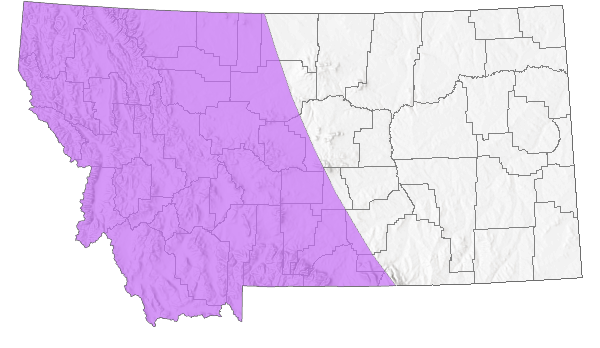
 Native
Native
Range Comments
From Alaska east across all of Canada except some of southern prairies, south in the west to the Washington Cascades and in the Rocky Mountains to New Mexico, in the eastern US to Maine and New Hampshire (Scott 1986, Guppy and Shepard 2001). Considered common to abundant (Glassberg 2001).
Observations in Montana Natural Heritage Program Database
Number of Observations: 10
(Click on the following maps and charts to see full sized version)
Map Help and Descriptions
Relative Density
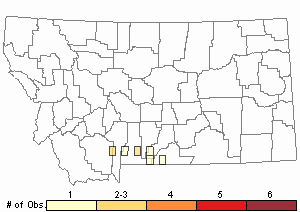
Recency

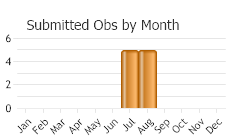
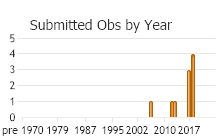
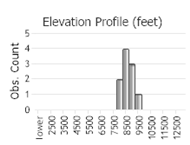 (Observations spanning multiple months or years are excluded from time charts)
(Observations spanning multiple months or years are excluded from time charts)
Migration
Non-migratory.
Habitat
Moist valley bottoms, montane meadows, alpine tundra (Scott 1986, Guppy and Shepard 2001).
Food Habits
Larval food plants include Dryas, Polygonum, Salix, Vaccinium, Viola; oviposition also noted on Leutkea, Lupinus, and Vaccinium (Scott 1986, Guppy and Shepard 2001, James and Nunnallee 2011). Adults feed on plant nectar, frequently visiting Solidago.
Reproductive Characteristics
Females deposit eggs singly on the undersides of host plant leaves or nearby. Females my lay up to 30 eggs or more in captivity. Eggs hatch in 6-10 days, larvae reach L4 instars in about 30 days after overwintering as L1 instars. Larvae overwinter as L1 instars in Washington and New Hampshire and as L4 instars in Colorado (possibly a second overwintering). Larve seem to be nocturnal, no nests are constructed (Scott 1986, James and Nunnallee 2011). Males patrol throughout the day in valley bottoms searching for females.
References
- Literature Cited AboveLegend:
 View Online Publication
View Online Publication Glassberg, J. 2001. Butterflies through Binoculars: A Field Guide to the Butterflies of Western North America. Oxford University Press.
Glassberg, J. 2001. Butterflies through Binoculars: A Field Guide to the Butterflies of Western North America. Oxford University Press. Guppy, C.S. and J.H. Shepard. 2001. Butterflies of British Columbia: including western Alberta, southern Yukon, the Alaska Panhandle, Washington, northern Oregon, northern Idaho, northwestern Montana. UBC Press (Vancouver, BC) and Royal British Columbia Museum (Victoria, BC). 414 pp.
Guppy, C.S. and J.H. Shepard. 2001. Butterflies of British Columbia: including western Alberta, southern Yukon, the Alaska Panhandle, Washington, northern Oregon, northern Idaho, northwestern Montana. UBC Press (Vancouver, BC) and Royal British Columbia Museum (Victoria, BC). 414 pp. James, D.G. and D. Nunnallee. 2011. Life histories of Cascadia butterflies. Corvallis, OR: Oregon State University Press. 447 p.
James, D.G. and D. Nunnallee. 2011. Life histories of Cascadia butterflies. Corvallis, OR: Oregon State University Press. 447 p. Scott, J.A. 1986. The butterflies of North America: a natural history and field guide. Stanford University Press, Stanford, California.
Scott, J.A. 1986. The butterflies of North America: a natural history and field guide. Stanford University Press, Stanford, California.
- Additional ReferencesLegend:
 View Online Publication
View Online Publication
Do you know of a citation we're missing? Allen, T.J., J.P. Brock, and J. Glassberg. 2005. Caterpillars in the field and garden: a field guide to the butterfly caterpillars of North America. Oxford University Press.
Allen, T.J., J.P. Brock, and J. Glassberg. 2005. Caterpillars in the field and garden: a field guide to the butterfly caterpillars of North America. Oxford University Press. Brock, J.P. and K. Kaufman. 2003. Kaufman Field Guide to Butterflies of North America. Houghton Mifflin Company, New York, NY 284 pp.
Brock, J.P. and K. Kaufman. 2003. Kaufman Field Guide to Butterflies of North America. Houghton Mifflin Company, New York, NY 284 pp. Caruthers, J.C., and D. Debinski. 2006. Montane meadow butterfly species distributions in the Greater Yellowstone Ecosystem. University of Wyoming National Park Service Research Center Annual Report, 2006. Vol. 30, Art. 14. 85-96.
Caruthers, J.C., and D. Debinski. 2006. Montane meadow butterfly species distributions in the Greater Yellowstone Ecosystem. University of Wyoming National Park Service Research Center Annual Report, 2006. Vol. 30, Art. 14. 85-96. Forister, M.L., C.A. Halsch, C.C. Nice, J.A. Fordyce, T.E. Dilts, J.C. Oliver, K.L. Prudic, A.M. Shapiro, J.K. Wilson, J. Glassberg. 2021. Fewer butterflies seen by community scientists across the warming and drying landscapes of the American West. Science 371:1042-1045.
Forister, M.L., C.A. Halsch, C.C. Nice, J.A. Fordyce, T.E. Dilts, J.C. Oliver, K.L. Prudic, A.M. Shapiro, J.K. Wilson, J. Glassberg. 2021. Fewer butterflies seen by community scientists across the warming and drying landscapes of the American West. Science 371:1042-1045. Fultz, J.E. 2005. Effects of shelterwood management on flower-visiting insects and their floral resources. M.Sc. Thesis. Bozeman, MT: Montana State University. 163 p.
Fultz, J.E. 2005. Effects of shelterwood management on flower-visiting insects and their floral resources. M.Sc. Thesis. Bozeman, MT: Montana State University. 163 p. Layberry, R.A., P.W. Hall, and J.D. LaFontaine. 1998. The Butterflies of Canada. University of Toronto Press. 280 pp. + color plates.
Layberry, R.A., P.W. Hall, and J.D. LaFontaine. 1998. The Butterflies of Canada. University of Toronto Press. 280 pp. + color plates. Maxell, B.A. 2016. Northern Goshawk surveys on the Beartooth, Ashland, and Sioux Districts of the Custer-Gallatin National Forest: 2012-2014. Montana Natural Heritage Program. Helena, MT. 114pp.
Maxell, B.A. 2016. Northern Goshawk surveys on the Beartooth, Ashland, and Sioux Districts of the Custer-Gallatin National Forest: 2012-2014. Montana Natural Heritage Program. Helena, MT. 114pp. Stanford, R.E. and P.A. Opler. 1993. Atlas of western USA butterflies: including adjacent parts of Canada and Mexico. Unpubl. Report. Denver and Fort Collins, Colorado 275 pp.
Stanford, R.E. and P.A. Opler. 1993. Atlas of western USA butterflies: including adjacent parts of Canada and Mexico. Unpubl. Report. Denver and Fort Collins, Colorado 275 pp.
- Web Search Engines for Articles on "Arctic Fritillary"
- Additional Sources of Information Related to "Insects"





